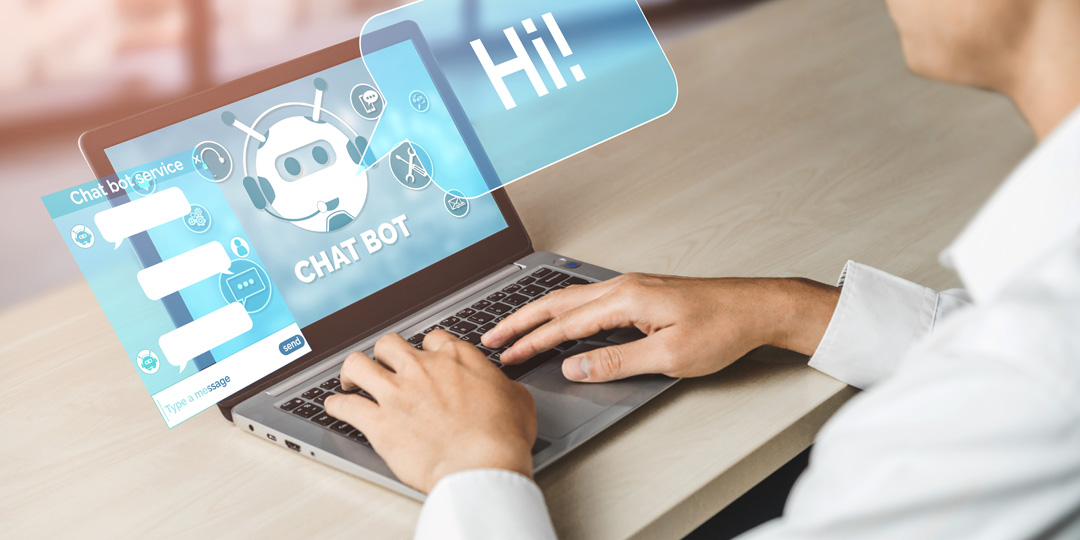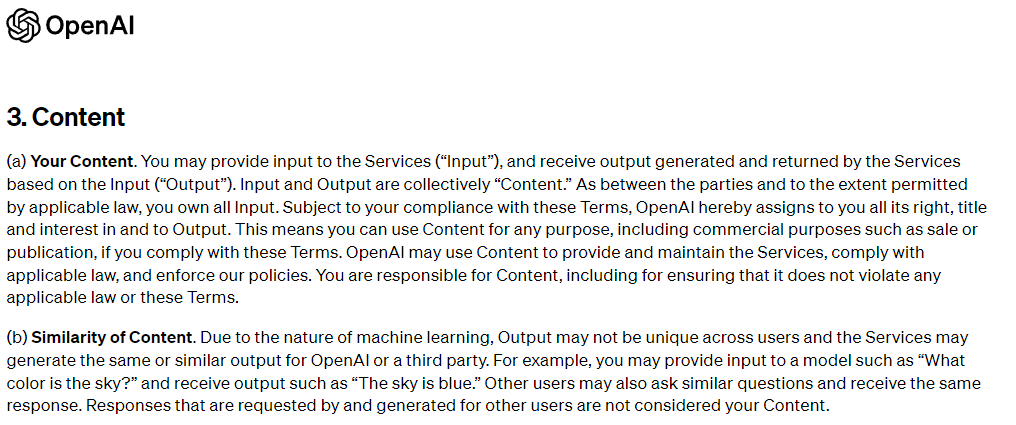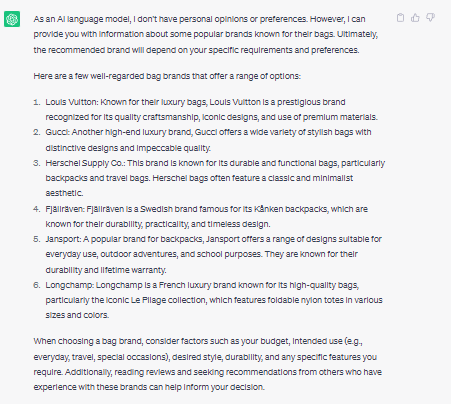AI CHATBOTS AND INTELLECTUAL PROPERTY RIGHTS

RAKSHANA. MK
Associate- IP Practice
“A computer would deserve to be called intelligent if it could deceive a human into believing that it was human.[i]”
– Alan Turing
In the recent times, terms such as Open AI, Bard, ChatGPT, etc. are making it to the headlines and have become one topic which has been discussed by a number of people irrespective of their age, the industry they work in or their geographical locations. There is increased expectation on the abilities of the above mentioned tools, at the same time, there is ambiguity and confusion with regards to the effect on the same on human lives. This article attempts to understand what AI Chat bots mean and what its implications on Intellectual Property Rights are.
It can be inferred that the ultimate aim of Artificial Intelligence is to create a machine that has the ability to talk, act and behave like a human being and undoubtedly, Chat bots do take us closer to the aim of such creators. When we take a look into the past, it can be understood that Chat bots were tools which could be used and afforded only by major businesses, but presently, immaterial of the revenue of the business, the funds held by the company, the status of the business, etc. every other websites incorporates a Chat bot, the only difference being the type of Chat bot.
Firstly answering the question as to what is an AI Chat bot, it can be defined as a computer program that uses artificial intelligence (AI) and natural language processing (NLP) to understand customer questions and automate responses to them, simulating human conversation[ii]. A simpler definition would be that it is a computer program which has the potential to simulate conversation with human users using the internet. Therefore it can be inferred that for a software or a platform to be considered as an AI Chatbot it has to:
- Be a computer program
- It should have the capacity to understand consumer questions, queries or needs
- It should have the capacity to generate response and
- It should give an experience of human like conversation.
When the system of basic chat bots were introduced and incorporated by website holders, one major advantage that it held was that it acted as a means to avoid human intervention and could swiftly provide the required information to the user, thus contributing towards saving time, cost and human effort. Looking into the other side of the coin, the traditional chat bots itself had its own fair share of threats. One common issue that every individual faces in this tech-savy- modern world, Data Privacy, the same served as a major threat as far as traditional chat bots were concerned as there have been instance of mass data theft due to lack of proper encryption mechanisms. Another common threat associated with chat bots are that it has the potential to be utilized as a platform to spread malware into devices, which again leads to data and monetary theft[iii].
One question that arises at this point is, what about the currently developed or can be termed as “in the process of development” AI or conversational chat bots? Are they developed or being developed in a manner that eliminates the above mentioned threats possessed by the traditional ones? There is no definite answer to this question, but one classic example is that of the most popular chat bot in the recent times, CHATGPT. As stated earlier, almost all the readers would have given an attempt to know what the bot is and what it is capable of, owing to the curiosity it has created in the recent times. When a user enters the bot’s page, it displays a message and the term of usage also mentions the same (please find the extract below) which can be inferred as a general disclaimer but still projects a picture that there is every possibility that such previously mentioned threats be exercised through the current platform/ technology too.

Now, all of us being familiar with the term CHATGPT, the full form of the expression GPT simply reads out to us and explains as to what the platform or any other similar platform performs. Generative Pre-trained Transformer (GPT) as the name suggests, the platform holds the ability to generate a content or an output which is derived out of the input that is fed into it; which is pre- trained with a transformer model. The only part that requires an explanation here is in relation to what a transformer model is and the scientific definition of the same is that “It is a neural network that learns context and thus meaning by tracking relationships in sequential data like the words in this sentence”[iv]. To elaborate, this aspect of the platform is programmed in a way that it tracks relationships between words used by the user in a particular sentence, which does not confine to one session of the chat but collects and connects relationships from various sessions, which ultimately leads it to project that it understands a user’s text, be it a conversation or a question, from which output is derived and the same is provided in a way that seems more human like or natural to the users. Not just CHATGPT, any other AI based model including Conversational AIs use similar mechanism.
Moving to the actual issue that the present article attempts to understand, what is the implication of such developments in the field of AI Bots on Intellectual Property?
To understand the same, it is important to take a look into it in two perspectives. (i) How does AI Bot affect Intellectual Property Rights and (ii) How can AI Bots be used for the benefit of Intellectual Property?
Looking into the negatives and limitations before the benefits (probably human nature; the machine would have preferred it the other way round!).
So Artificial Intelligence and the registrability of the content generated by the platform under Intellectual Property laws has been a question that has been debated at least since the year 2020 and the fact is that we still haven’t arrived at a proper conclusive answer to the same. We see different jurisdictions viewing and analyzing the same question in different manners. Now as far as AI bots are concerned, one major question here is in relation to the output generated by the platform, who owns its Intellectual Property Rights? For this purpose it is important to look into the Terms of Use of the respective AI Chatbot platform, which may vary from application to application. Taking the example of CHATGPT it states the following:

So, according to the terms of CHATGPT, it specifically states that “you own all Input, and subject to your compliance with these Terms, OpenAI hereby assigns to you all its right, title and interest in and to Output”. Thus, we can conclude that the question as to the rights vested in the input doesn’t arise here but what about the output and the IP rights vested in it? If we consider the terms of the platform, we can simply term them to be impossible and impractical. When the terms explicitly mentions that there is every possibility of similarity of output generated by the platform, for instance, when two users arrive at the same output does it mean that both hold the rights on that particular output? The debate of can AI or an AI Platform hold IP rights still stays, so as far as the Indian perspective is concerned we can conclude that the platform itself cannot hold the IP rights of the output generated. Does this in any way help us in arriving at a conclusion with regards to the question in relation to who owns the IP? The answer is a simple NO. We can simply understand that there exists ambiguity as to IP and its associated rights of the content generated by the platform.
Secondly, the platform itself mentions that it has been fed into huge amounts of data. There is every possibility that it includes third part IP protected data. Taking another perspective, for the output to be derived, there ought to be an input fed into it and in the case of AI Chat bots it can be stated that the query, question or the conversation initiated by the user is the input. Considering Sec. 2(d)(vi) of the Indian Copyright Act, 1957 in the case of computer-generated works the Act allows grant of authorship to the person “who causes the work to be created”[v]. Now in this scenario another question to ponder is that should a user who has merely provided a one-line Input be considered to have caused the Output and should the user be granted the authorship of the content generated or should the programmer who feeds into large amount of data into the platform be considered as the person who causes the output? Again, we do not have a definite and affirmative answer to the same.
Another interesting scenario, there exists various AI based Chat bots, which can be accessed only if it is subscribed for, in other words, they are paid versions. In such a case can we conclude that the usage of copyrighted material for the purpose of feeding in data to the platform be considered as a major copyright infringement owing to the fact that there exists monetary gains and can be termed as Commercial Exploitation or would it fall under the category of fair use?
Next comes the question in relation to trademarks and brand image. A small excerpt from CHATGPT shows how it has the potential to influence human mind in relation to brands.

Though the platform provides the user with a disclaimer as to it doesn’t have any personal opinion or preference and that you need to consider various factors to arrive at a decision, it chooses to provide the user with a list of recommended brands, which has the potential to influence a human/ user’s mind.
The case of Doe v. GitHub[vi]: In November 2022, a putative class action lawsuit was initiated against GitHub, Microsoft and OpenAI alleging that the companies trained and developed two generative AI tools based on copyrighted licensed material and code. The Plaintiff claim that the act of using its protected and licensed work in the development of the Defendants’ platforms constituted to violation of open source licenses and is an act of infringing its IP rights. In a similar case, in January 2023, Anderson v. Stability AI[vii], artists filed a lawsuit against Stability AI, Midjourney and DeviantArt for copyright infringement over the unauthorized use of their copyrighted images to develop and train AI tools. Similarly in February 2023, Getty Images filed a suit against the company Stability AI, accusing them of infringing its copyrights by misusing Getty’s photos to train and develop its AI art-generation tool. Thus it can be understood that the IP infringement actions and lawsuits initiated so far are only the tip of the iceberg and looking at the rapid development of AI based Chat bots, there’s more coming and are worth waiting for.
It is pertinent to mention here the U.S. Copyright Office provided guidance in relation to Copyright applications for work that contain content generated by AI owing to the fact that many applicants failed to the mention involvement of AI platform to generate content in their applications. The Copyright Office states that “to qualify as a work of ‘authorship’ a work must be created by a human being” and that it “will not register works produced by a machine or mere mechanical process that operates randomly or automatically without any creative input or intervention from a human author” It also mentioned that the extent of AIs contribution to the creative process of the work would be a major factor of consideration and also stated that “an artist may modify material originally generated by AI technology to such a degree that the modifications meet the standard for copyright protection”. It is important to note here that as far as these cases are concerned, copyright will only protect the human-authored aspects of the work, which are “independent of” and do “not affect” the copyright status of the AI-generated material itself[viii].
Now, moving on to how such AI Chat bots can be used for the benefit of IP.
- It can be used to provide information about Intellectual Property. Again here arises the question of reliability. There have been instances where certain platforms provide two different answers which are definite, which human knowledge asserts is false. Thus it can be used as a tool to provide basic information. For instance, can be used to explain what Intellectual Property Rights are to a 10 year old.
- It is capable of generating content that can be used for Intellectual Property applications such as patent or trade mark applications. Drafting assistance can be obtained in relation to preparation of various documents required for the process of application, which again comes with restrictions such as a watch has to be kept on providing confidential information, reliability, etc.
Thus in conclusion, it can be stated that there exists ambiguity in relation to how IP can be protected from infringements in AI Chatbot platforms and there again arises a question as to if the existing forms of IP are sufficient enough to protect the inventions/ contents generated by AI bots to which the answer is negative and there are immediate requirements of developments in legislations to facilitate the same so that law can keep up with technology. It can be stated that such AI Chat bots can be both advantageous and disadvantageous, positively if used only as a tool to support and not as a replacement to human intellectual.
[i] https://www.hollywoodreporter.com/news/general-news/alan-turings-5-powerful-quotes-752669/
[ii] WHAT IS A CHATBOT? https://www.ibm.com/topics/chatbots#:~:text=A%20chatbot%20is%20a%20computer,337%25%20ROI%20over%20three%20years.
[iii] Chatbots are everywhere, but do they pose privacy concerns?; https://www.kaspersky.com/resource-center/preemptive-safety/chatbots
[iv] ChatGPT and Intellectual Property (IP); PatentNext; March 27, 2023; https://www.patentnext.com/2023/03/chatgpt-and-intellectual-property-ip-related-topics/
What is a Transformer Model? https://blogs.nvidia.com/blog/2022/03/25/what-is-a-transformer-model/
[v] Sec.2(d) “author’’ means,— (i) in relation to a literary or dramatic work, the author of the work; (ii) in relation to a musical work, the composer; (iii) in relation to an artistic work other than a photograph, the artist; (iv) in relation to a photograph, the person taking the photograph; [(v) in relation to a cinematograph film or sound recording, the producer; and [(v) in relation to a cinematograph film or sound recording, the producer; and” (vi) in relation to any literary, dramatic, musical or artistic work which is computer-generated, the person who causes the work to be created;].
[vi] https://www.documentcloud.org/documents/23323955-doe-v-github-class-action-complaint
[vii] AI Generated Images- The first lawsuit; https://journals.library.columbia.edu/index.php/stlr/blog/view/479
[viii] Copyright Registration Guidance: Works Containing Material Generated by Artificial Intelligence; Federal Register; A Rule by the Copyright Office, Library of Congress; 03/16/2023; https://www.federalregister.gov/documents/2023/03/16/2023-05321/copyright-registration-guidance-works-containing-material-generated-by-artificial-intelligence
Terms Of Usage- CHATGPT; https://openai.com/policies/terms-of-use



